
Baron Inchiquin is one of the older titles in the Peerage of Ireland. It was one of two titles created on 1 July 1543 for Murrough O'Brien, Prince of Thomond, who claimed descent from Brian Boru, a High King of Ireland. The grant of the English titles was conditional upon the abandonment of any Irish titles, the adoption of English customs and laws, pledging of allegiance to the Crown, apostasy from the Catholic Church, and conversion to the Church of Ireland. Murrough was made both Earl of Thomond in the Peerage of Ireland, with remainder to his nephew Donough O'Brien and Baron Inchiquin, with remainder to his male heirs. Following the death of his cousin, Conor Myles John O' Brien in June 2023, Conor John Anthony O' Brien is currently the 19th Baron Inchiquin
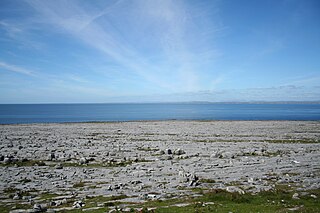
The Burren is a karst/glaciokarst landscape centred in County Clare, on the west coast of Ireland. It measures around 530 square kilometres (200 sq mi), within the circle made by the villages of Lisdoonvarna, Corofin, Gort and Kinvara. The area includes such natural features as Mullaghmore hill and Ailladie cliffs, and historic monuments such as Poulnabrone dolmen and Caherconnell Stone Fort. The Burren National Park covers a small part of the Burren and is the smallest of the six National Parks in Ireland, while the adjacent territory, including the Cliffs of Moher, is included in the Burren and Cliffs of Moher Geopark.
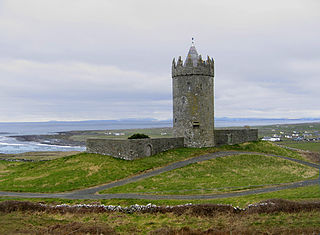
Doonagore Castle is a round 16th-century tower house with a small walled enclosure located about 1 km south of the coastal village of Doolin in County Clare, Ireland. Its name may be derived from Dún na Gabhair, meaning "the fort of the rounded hills" or the "fort of the goats". Doonagore Castle is at present a private holiday home, inaccessible to the public.

Corofin is a town on the River Fergus in northern County Clare, Ireland and also a parish of the same name in the Catholic Diocese of Killaloe.

Sir Murrough O'Brien, 10th Baron of Inchiquin, 5th Baron O'Brien of Burren, 1st Baron Thomond of Taplow, 5th Earl of Inchiquin, 1st Marquess of Thomond KP, PC (Ire), known from 1777 to 1800 as the 5th Earl of Inchiquin, was an Irish peer, soldier and politician.

Corcomroe Abbey is an early 13th-century Cistercian monastery located in the north of the Burren region of County Clare, Ireland, a few miles east of the village of Ballyvaughan in the Barony of Burren. It was once known as "St. Mary of the Fertile Rock", a reference to the Burren's fertile soil.

Ballinalacken Castle is a two-stage tower house located in Killilagh parish of County Clare, Ireland. It is of uncertain date but most likely was built in the 15th or early 16th century.

Kilnaboy or Killinaboy is a village, townland and civil parish in County Clare, Ireland. It is located in the Burren, and as of the 2011 census the area had 347 inhabitants.

Lucius (McEdward) O'Brien, 13th Baron Inchiquin, known as Sir Lucius O'Brien, 5th Baronet from 1837 to 1855, was an Irish politician and nobleman. He is remembered respectfully in County Clare for his relief work in the famine years.

Donough Edward Foster O'Brien, 16th Baron Inchiquin was an Irish peer and 29th direct descendant of Brian Boru.

Sir Donough O'Brien, 1st Baronet of Leameneh was an Irish politician and baronet.

Sir Edward O'Brien, 2nd Baronet was an Irish politician and baronet.
Conor Myles John O'Brien, 18th Baron Inchiquin, The O’Brien, Prince of Thomond, and 10th Baronet of Leamaneh, was an English-born Irish clan chief and holder of an Irish peerage. Although his family's ancestral home, Dromoland Castle, was sold, he remained owner of a large house and substantial estate in Dromoland, County Clare until his death.
The MacMahon Baronetcy, of Clonderalaw in the County of Clare, was a title in the Baronetage of Ireland. It was created on 15 August 1628 for Teague MacMahon. The title is presumed to have become extinct on the death of the second Baronet sometime after 1683.

Killilagh or Killeilagh is a civil parish in County Clare, Ireland. It contains the village of Doolin.
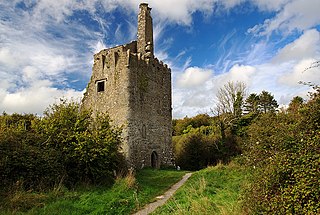
Dromore Castle is a tower house and National Monument located between the towns of Crusheen and Corofin in County Clare, Ireland.
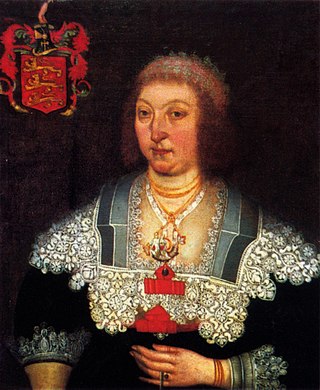
Máire Rua O'Brien was an Irish aristocrat who married three times to retain family lands. Born into the MacMahon family of Thomond, her name, Máire Rua or Red Mary, derived from her red hair. First married to Daniel Neylon (O'Neillan) of Dysert O'Dea Castle in north County Clare, after his death in 1639, she married Conor O'Brien of Leamaneh Castle. With her second husband, she backed the Royalist cause against Cromwell's forces during the Eleven Years' War. However, after her second husband was killed in 1651, she married a Cromwellian officer; in a reputed attempt to save her estate. Remaining on her estate at Leamaneh for several decades, her son Donough O'Brien moved the family seat to the larger Dromoland Castle where she lived until her death in 1686. A sometimes notorious figure in Irish folklore, a number of exaggerated stories and legends are associated with her life.
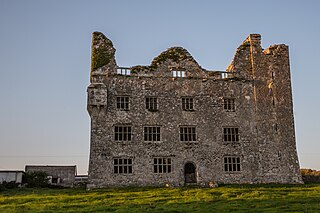
Conor O'Brien of Leameneagh (1617–1651) was a Royalist Commander in County Clare during the Irish Confederate Wars.

Sir Donough O'Brien (1595-1634) was an Irish nobleman of the O'Brien family of Leameneagh.
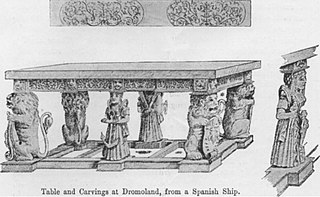
Conor O'Brien of Leameneagh was an Irish nobleman and land-owner in County Clare.




















